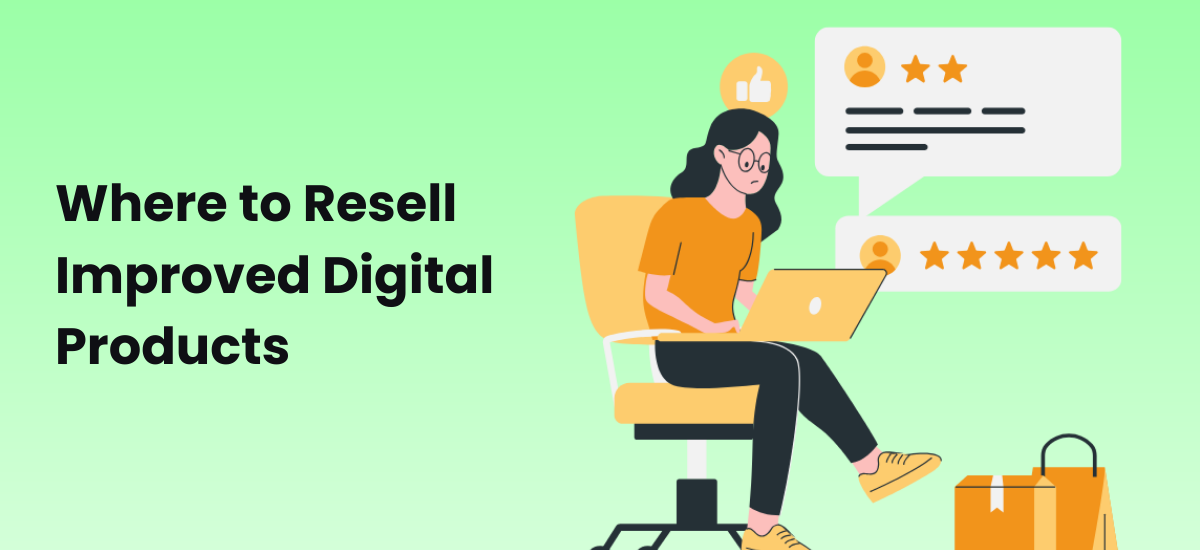
In today’s digital-first world, buying and selling online assets is becoming one of the fastest and smartest ways to generate income. Known as “digital product flipping,” this method involves purchasing undervalued digital products, improving them, and reselling them at a higher price. Think of it as the online version of house flipping, but with lower overheads and higher scalability.
In this blog, we’ll explore what digital product flipping is, how to get started, where to find products, how to improve them, and tips to resell them effectively. Whether you’re a freelancer, marketer, developer, or digital entrepreneur, this guide will help you dive into the world of digital flipping with confidence.
What is Digital Product Flipping?

Digital product flipping is the practice of acquiring digital assets or products—such as eBooks, templates, courses, websites, software, or graphic design packs—improving their quality, usability, or appeal, and reselling them for a profit. These improvements may include design enhancements, better SEO, adding valuable content, or updating functionality.
This business model has gained popularity due to the low cost of entry, quick turnaround, and potential for passive income. With the rise in demand for digital tools and content, digital flipping has emerged as a high-opportunity space for individuals and small businesses alike.
Types of Digital Products You Can Flip

- Website Domains and Starter Sites
Buy underperforming websites or expired domains, enhance their SEO, content, and design, and resell them for higher prices on platforms like Flippa or Empire Flippers. You can also add monetization features like affiliate links or display ads to increase the value of these sites.
- eBooks and Courses
Purchase PLR (Private Label Rights) content, update it with fresh content, better design, or video elements, and resell on platforms like Gumroad, Teachable, or your own site. Educational content has evergreen demand, especially in niches like health, finance, productivity, and self-improvement.
- Design Templates
Buy Canva or Photoshop templates, rebrand or enhance them, and sell to bloggers, marketers, or small businesses. These are especially popular on Creative Market, Etsy, and even as digital bonuses in online programs.
- Digital Tools or Software (SaaS)
Acquire minimal viable software products (MVPs), improve functionality or UI/UX, and resell with licensing or subscription models. The key is identifying a real pain point and solving it more efficiently than existing tools.
- Printables and Digital Planners
Rework or bundle existing planners, worksheets, or calendars and market them on Etsy or your own eCommerce store. These are low-effort, high-reward products for moms, students, business owners, and productivity seekers.
Where to Find Digital Products to Flip?

- Flippa.com – Buy and sell websites, domains, and online businesses. It’s one of the most established marketplaces for digital flipping.
- Creative Market / Envato Elements – Find design templates, fonts, and digital assets. You can license, customize, and relist on different platforms.
- Gumroad / Payhip – Buy low-cost digital products and rework for resale. Great for digital bundles and personal finance products.
- PLR Websites – Access thousands of ready-to-use content pieces. Some popular PLR sites include PLR.me, IDPLR, and Resell Rights Weekly.
- CodeCanyon – For software scripts and small SaaS tools. Developers often sell MVPs or niche tools that can be refined and rebranded.
Where to Resell Improved Digital Products?

- Etsy – Great for planners, printables, and design templates. Etsy’s audience appreciates aesthetic value and niche-specific items.
- Gumroad / Payhip – Ideal for eBooks, courses, and digital bundles. These platforms offer simple payment processing and product delivery.
- Your Own Website – Use Shopify or WordPress to sell and brand yourself as a creator. This gives you full control over customer experience and pricing.
- Flippa – Sell upgraded websites or domains. Add analytics reports, profit summaries, and screenshots to enhance the listing.
- AppSumo Marketplace – For launching improved SaaS tools or templates. AppSumo attracts tech-savvy customers and early adopters.
Tips for Successful Digital Flipping
- Start Small – Begin with low-cost products to test the process and learn. Avoid investing heavily until you understand the market.
- Know Your Audience – Understand who will benefit most from the improved product. Research your niche on forums, Reddit, or Facebook groups.
- Focus on Quality – Don’t just resell—add real value. Always aim for better design, more depth, and usability.
- Use Automation Tools – Automate emails, customer service, and delivery. Tools like Zapier, Mailchimp, and Shopify apps can save time.
- Build a Brand – Consistent design and branding help in trust and sales. Use a unique logo, color palette, and brand tone across all listings.
- Collect Customer Feedback – Learn from your buyers. Use feedback to refine future products and improve resale value.
- Track Metrics – Monitor sales, conversion rates, and traffic to understand what works and replicate it.
SEO Tips to Promote Your Flipped Products
- Use long-tail keywords relevant to your niche. Example: “printable wedding planner” or “minimalist blog templates.”
- Write compelling product descriptions with keyword optimization. Highlight features, benefits, and use cases.
- Create blog content around your product to drive organic traffic. How-to guides, comparison posts, and tutorials work well.
- Build backlinks by submitting to directories, engaging in communities, and guest posting on niche sites.
- Use Pinterest and YouTube for visual product promotion. These platforms drive high-intent traffic for digital goods.
- Leverage email marketing to promote launches, discounts, and updates.
Common Mistakes to Avoid
- Skipping market research – Always validate demand before purchasing or improving a product.
- Ignoring copyright/license terms – Ensure the product allows resale or commercial use.
- Overpricing – While you want profit, ensure pricing aligns with perceived value and competition.
- Poor customer support – Even digital buyers expect timely help and responses.
- Not testing the product – Always check for functionality and usability before listing.
Final Thoughts
Digital product flipping is an exciting and profitable venture for anyone willing to put in the time to improve and market products effectively. With low startup costs, flexible options, and growing demand for digital assets, this strategy is perfect for freelancers, solopreneurs, and digital side hustlers.
The key to success lies in smart sourcing, thoughtful improvements, strategic marketing, and a clear understanding of your audience. Whether you’re flipping a blog template or a full SaaS product, always aim to deliver value and solve problems.
So, are you ready to dive in and flip your first digital product for profit? Start small, stay consistent, and watch your digital income grow!






